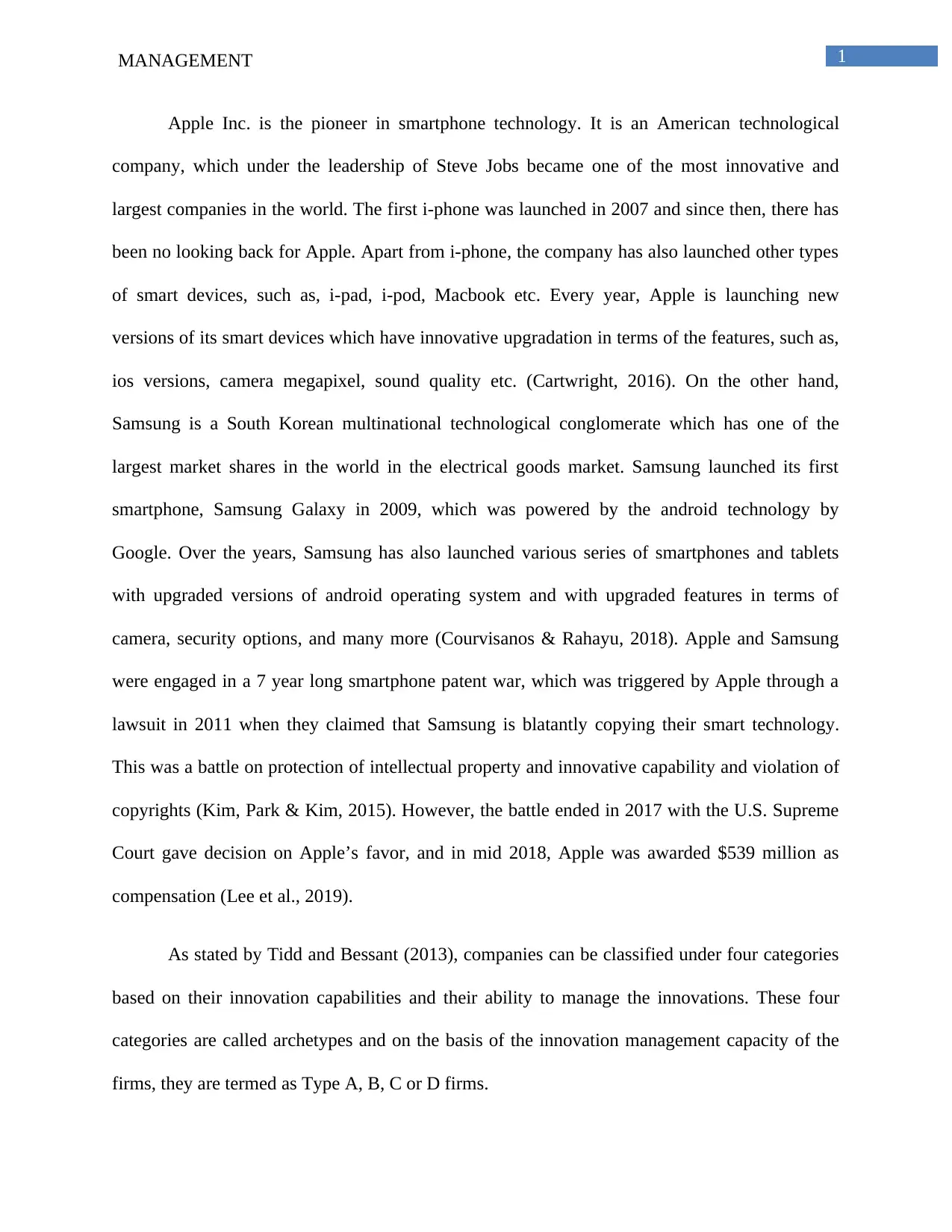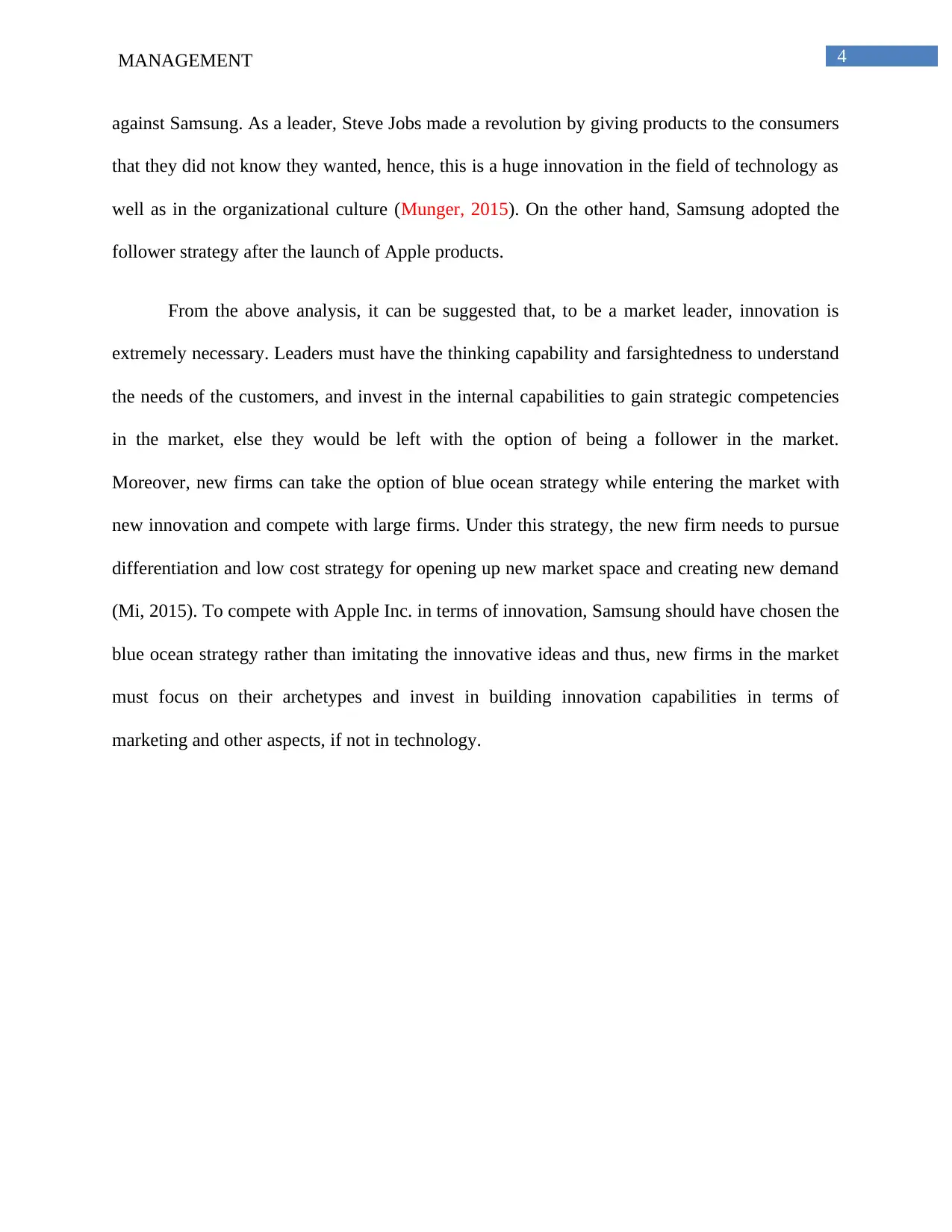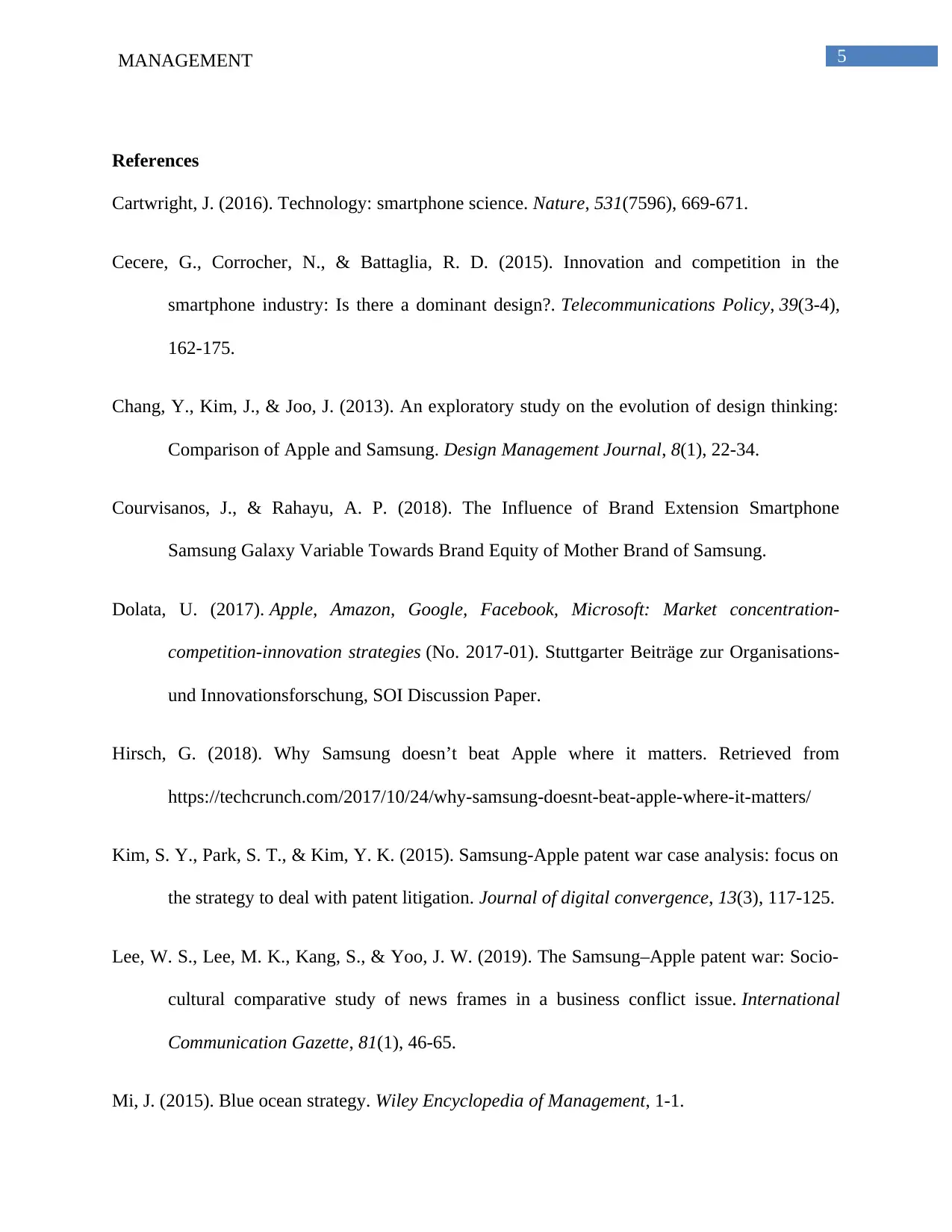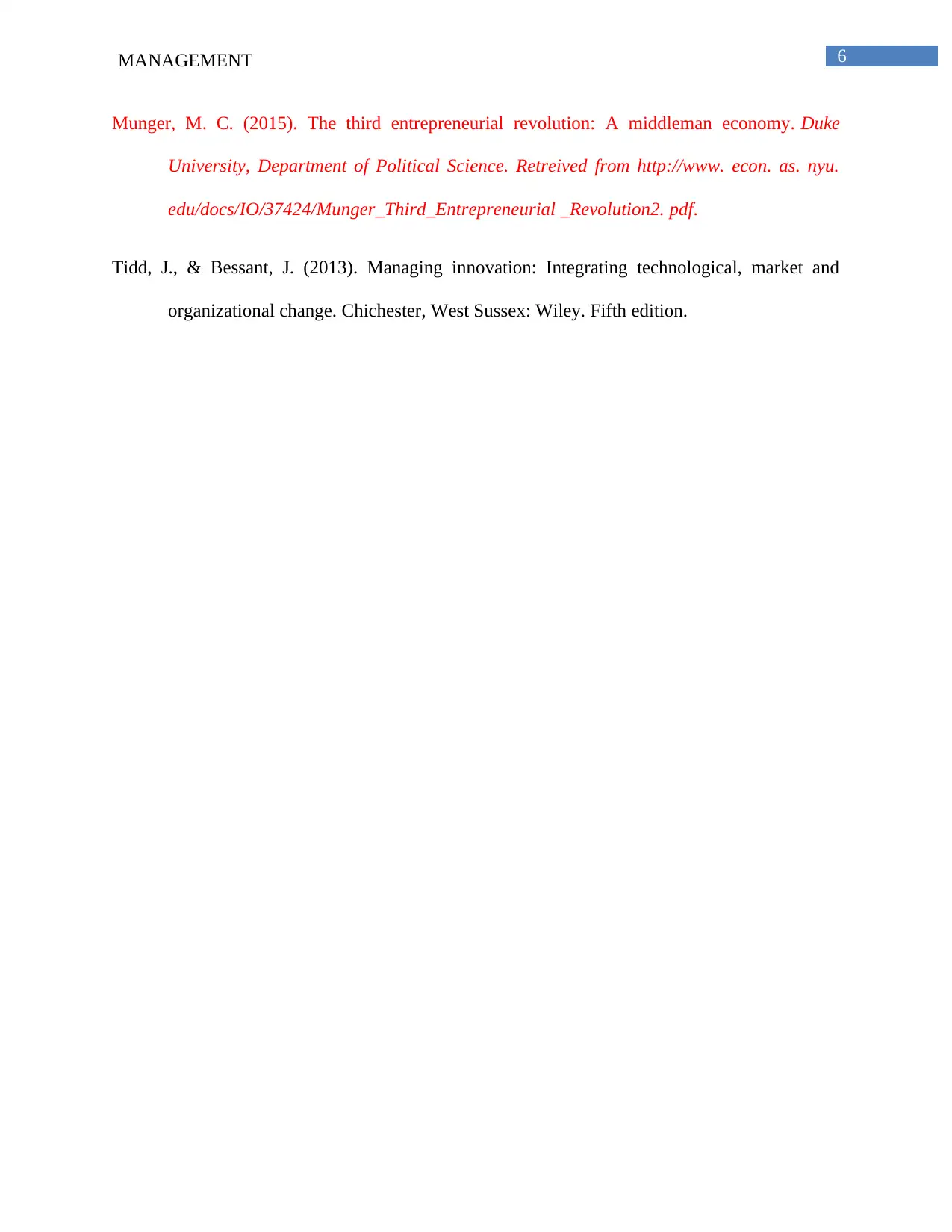Apple & Samsung: Comparative Analysis of Innovation Capabilities
VerifiedAdded on 2023/01/18
|7
|1624
|90
Essay
AI Summary
This essay provides a comparative analysis of the innovation capabilities of Apple Inc. and Samsung Electronics, categorizing Apple as a Type D firm (creative) and Samsung as a Type C firm (strategic) based on Tidd and Bessant's innovation archetypes. It highlights Apple's first-mover advantage in the smartphone market and its innovative marketing strategies, contrasting it with Samsung's follower strategy and reliance on channel partners. The essay also touches upon the patent war between the two companies and suggests that Samsung could have benefited from adopting a blue ocean strategy to differentiate itself and compete more effectively with Apple. The analysis emphasizes the importance of internal capabilities and farsighted leadership in driving innovation and achieving market leadership, suggesting that new firms should focus on building strong innovation capabilities to compete with larger, established companies. Desklib offers a variety of resources, including past papers and solved assignments, to aid students in their studies.

Running head: MANAGEMENT
Comparison of Apple Inc and Samsung Electronics Innovation Capabilities
Name of the Student:
Name of the University:
Author note:
Comparison of Apple Inc and Samsung Electronics Innovation Capabilities
Name of the Student:
Name of the University:
Author note:
Paraphrase This Document
Need a fresh take? Get an instant paraphrase of this document with our AI Paraphraser

1MANAGEMENT
Apple Inc. is the pioneer in smartphone technology. It is an American technological
company, which under the leadership of Steve Jobs became one of the most innovative and
largest companies in the world. The first i-phone was launched in 2007 and since then, there has
been no looking back for Apple. Apart from i-phone, the company has also launched other types
of smart devices, such as, i-pad, i-pod, Macbook etc. Every year, Apple is launching new
versions of its smart devices which have innovative upgradation in terms of the features, such as,
ios versions, camera megapixel, sound quality etc. (Cartwright, 2016). On the other hand,
Samsung is a South Korean multinational technological conglomerate which has one of the
largest market shares in the world in the electrical goods market. Samsung launched its first
smartphone, Samsung Galaxy in 2009, which was powered by the android technology by
Google. Over the years, Samsung has also launched various series of smartphones and tablets
with upgraded versions of android operating system and with upgraded features in terms of
camera, security options, and many more (Courvisanos & Rahayu, 2018). Apple and Samsung
were engaged in a 7 year long smartphone patent war, which was triggered by Apple through a
lawsuit in 2011 when they claimed that Samsung is blatantly copying their smart technology.
This was a battle on protection of intellectual property and innovative capability and violation of
copyrights (Kim, Park & Kim, 2015). However, the battle ended in 2017 with the U.S. Supreme
Court gave decision on Apple’s favor, and in mid 2018, Apple was awarded $539 million as
compensation (Lee et al., 2019).
As stated by Tidd and Bessant (2013), companies can be classified under four categories
based on their innovation capabilities and their ability to manage the innovations. These four
categories are called archetypes and on the basis of the innovation management capacity of the
firms, they are termed as Type A, B, C or D firms.
Apple Inc. is the pioneer in smartphone technology. It is an American technological
company, which under the leadership of Steve Jobs became one of the most innovative and
largest companies in the world. The first i-phone was launched in 2007 and since then, there has
been no looking back for Apple. Apart from i-phone, the company has also launched other types
of smart devices, such as, i-pad, i-pod, Macbook etc. Every year, Apple is launching new
versions of its smart devices which have innovative upgradation in terms of the features, such as,
ios versions, camera megapixel, sound quality etc. (Cartwright, 2016). On the other hand,
Samsung is a South Korean multinational technological conglomerate which has one of the
largest market shares in the world in the electrical goods market. Samsung launched its first
smartphone, Samsung Galaxy in 2009, which was powered by the android technology by
Google. Over the years, Samsung has also launched various series of smartphones and tablets
with upgraded versions of android operating system and with upgraded features in terms of
camera, security options, and many more (Courvisanos & Rahayu, 2018). Apple and Samsung
were engaged in a 7 year long smartphone patent war, which was triggered by Apple through a
lawsuit in 2011 when they claimed that Samsung is blatantly copying their smart technology.
This was a battle on protection of intellectual property and innovative capability and violation of
copyrights (Kim, Park & Kim, 2015). However, the battle ended in 2017 with the U.S. Supreme
Court gave decision on Apple’s favor, and in mid 2018, Apple was awarded $539 million as
compensation (Lee et al., 2019).
As stated by Tidd and Bessant (2013), companies can be classified under four categories
based on their innovation capabilities and their ability to manage the innovations. These four
categories are called archetypes and on the basis of the innovation management capacity of the
firms, they are termed as Type A, B, C or D firms.

2MANAGEMENT
Figure 1: Archetypes of firms in terms of innovation
(Source: Tidd & Bessant, 2013)
There are four archetypes, namely, Type A: unaware or passive; Type B: Reactive; Type
C: Strategic and Type D: Creative. According to Tidd & Bessant (2013), Type C firms have the
sense for the need of change and also have the capability of implementing changes by choosing
the appropriate strategic framework or approach towards continuous innovation. However, these
firms lack the capability of radical innovation, that is, redefining the market through new
technology or creating new market opportunities. Hence, they often get trapped in limited
boundaries of know-how. On the other hand, the Type D firms operate at the highest level of
international frontier of knowledge and have the ability in taking proactive and creative approach
in exploiting the technological and the market knowledge for gaining competitive advantage via
diverse and extensive networks. These firms have very strong internal sources along with high
degree of absorptive capacity.
Figure 1: Archetypes of firms in terms of innovation
(Source: Tidd & Bessant, 2013)
There are four archetypes, namely, Type A: unaware or passive; Type B: Reactive; Type
C: Strategic and Type D: Creative. According to Tidd & Bessant (2013), Type C firms have the
sense for the need of change and also have the capability of implementing changes by choosing
the appropriate strategic framework or approach towards continuous innovation. However, these
firms lack the capability of radical innovation, that is, redefining the market through new
technology or creating new market opportunities. Hence, they often get trapped in limited
boundaries of know-how. On the other hand, the Type D firms operate at the highest level of
international frontier of knowledge and have the ability in taking proactive and creative approach
in exploiting the technological and the market knowledge for gaining competitive advantage via
diverse and extensive networks. These firms have very strong internal sources along with high
degree of absorptive capacity.
⊘ This is a preview!⊘
Do you want full access?
Subscribe today to unlock all pages.

Trusted by 1+ million students worldwide

3MANAGEMENT
Going by the above the explanation, it can be said that Apple Inc. is a Type D firm, while
Samsung is Type C firm. Apple was able to bring a radical change in the market of technology
and smart devices. Although Samsung had established itself in the market of electronics, such as,
LED and HD televisions, various kitchen and home appliances, computers, etc., yet, it could not
bring smart technology based devices like smartphones and tablets as a first in the market and
followed the move by Apple Inc. Thus, Apple adopted the first mover strategy in innovation of
smart phones and other devices (Cecere, Corrocher & Battaglia, 2015).
Apple is more innovative in its marketing and sales in comparison to Samsung. While Apple
prefers to establish a personal touch in their marketing activities, Samsung lacks in it, which is
why people prefer to buy Apple phones and other smart devices than the Samsung ones even if
they provide state-of-the-art devices with equal performance. Apple takes a direct approach
while launching its new products and before divulging the features, they describe their personal
experiences (Dolata, 2017). On the other hand, Samsung’s leadership strategy does not pay much
attention to direct consumer interaction as opposed to Apple Inc. Samsung relies heavily on the
channel partners to sell their devices and spend large money on them rather than investing on
internal capabilities for innovations (Chang, Kim & Joo, 2013). Furthermore, while launching
the products they start straight with product features rather than establishing a personal
connection, and hence, the innovative personal touch is lacking in their marketing activities
(Hirsch, 2018).
Both the companies adopt incremental innovation strategy but the level of innovation in
the features is much more in the Apple products than in the Samsung products. The level of
performance is also getting better for Apple with its new versions. The lawsuit against Samsung
that alleged that they were copying the designs and features of Apple devices was a hard hit
Going by the above the explanation, it can be said that Apple Inc. is a Type D firm, while
Samsung is Type C firm. Apple was able to bring a radical change in the market of technology
and smart devices. Although Samsung had established itself in the market of electronics, such as,
LED and HD televisions, various kitchen and home appliances, computers, etc., yet, it could not
bring smart technology based devices like smartphones and tablets as a first in the market and
followed the move by Apple Inc. Thus, Apple adopted the first mover strategy in innovation of
smart phones and other devices (Cecere, Corrocher & Battaglia, 2015).
Apple is more innovative in its marketing and sales in comparison to Samsung. While Apple
prefers to establish a personal touch in their marketing activities, Samsung lacks in it, which is
why people prefer to buy Apple phones and other smart devices than the Samsung ones even if
they provide state-of-the-art devices with equal performance. Apple takes a direct approach
while launching its new products and before divulging the features, they describe their personal
experiences (Dolata, 2017). On the other hand, Samsung’s leadership strategy does not pay much
attention to direct consumer interaction as opposed to Apple Inc. Samsung relies heavily on the
channel partners to sell their devices and spend large money on them rather than investing on
internal capabilities for innovations (Chang, Kim & Joo, 2013). Furthermore, while launching
the products they start straight with product features rather than establishing a personal
connection, and hence, the innovative personal touch is lacking in their marketing activities
(Hirsch, 2018).
Both the companies adopt incremental innovation strategy but the level of innovation in
the features is much more in the Apple products than in the Samsung products. The level of
performance is also getting better for Apple with its new versions. The lawsuit against Samsung
that alleged that they were copying the designs and features of Apple devices was a hard hit
Paraphrase This Document
Need a fresh take? Get an instant paraphrase of this document with our AI Paraphraser

4MANAGEMENT
against Samsung. As a leader, Steve Jobs made a revolution by giving products to the consumers
that they did not know they wanted, hence, this is a huge innovation in the field of technology as
well as in the organizational culture (Munger, 2015). On the other hand, Samsung adopted the
follower strategy after the launch of Apple products.
From the above analysis, it can be suggested that, to be a market leader, innovation is
extremely necessary. Leaders must have the thinking capability and farsightedness to understand
the needs of the customers, and invest in the internal capabilities to gain strategic competencies
in the market, else they would be left with the option of being a follower in the market.
Moreover, new firms can take the option of blue ocean strategy while entering the market with
new innovation and compete with large firms. Under this strategy, the new firm needs to pursue
differentiation and low cost strategy for opening up new market space and creating new demand
(Mi, 2015). To compete with Apple Inc. in terms of innovation, Samsung should have chosen the
blue ocean strategy rather than imitating the innovative ideas and thus, new firms in the market
must focus on their archetypes and invest in building innovation capabilities in terms of
marketing and other aspects, if not in technology.
against Samsung. As a leader, Steve Jobs made a revolution by giving products to the consumers
that they did not know they wanted, hence, this is a huge innovation in the field of technology as
well as in the organizational culture (Munger, 2015). On the other hand, Samsung adopted the
follower strategy after the launch of Apple products.
From the above analysis, it can be suggested that, to be a market leader, innovation is
extremely necessary. Leaders must have the thinking capability and farsightedness to understand
the needs of the customers, and invest in the internal capabilities to gain strategic competencies
in the market, else they would be left with the option of being a follower in the market.
Moreover, new firms can take the option of blue ocean strategy while entering the market with
new innovation and compete with large firms. Under this strategy, the new firm needs to pursue
differentiation and low cost strategy for opening up new market space and creating new demand
(Mi, 2015). To compete with Apple Inc. in terms of innovation, Samsung should have chosen the
blue ocean strategy rather than imitating the innovative ideas and thus, new firms in the market
must focus on their archetypes and invest in building innovation capabilities in terms of
marketing and other aspects, if not in technology.

5MANAGEMENT
References
Cartwright, J. (2016). Technology: smartphone science. Nature, 531(7596), 669-671.
Cecere, G., Corrocher, N., & Battaglia, R. D. (2015). Innovation and competition in the
smartphone industry: Is there a dominant design?. Telecommunications Policy, 39(3-4),
162-175.
Chang, Y., Kim, J., & Joo, J. (2013). An exploratory study on the evolution of design thinking:
Comparison of Apple and Samsung. Design Management Journal, 8(1), 22-34.
Courvisanos, J., & Rahayu, A. P. (2018). The Influence of Brand Extension Smartphone
Samsung Galaxy Variable Towards Brand Equity of Mother Brand of Samsung.
Dolata, U. (2017). Apple, Amazon, Google, Facebook, Microsoft: Market concentration-
competition-innovation strategies (No. 2017-01). Stuttgarter Beiträge zur Organisations-
und Innovationsforschung, SOI Discussion Paper.
Hirsch, G. (2018). Why Samsung doesn’t beat Apple where it matters. Retrieved from
https://techcrunch.com/2017/10/24/why-samsung-doesnt-beat-apple-where-it-matters/
Kim, S. Y., Park, S. T., & Kim, Y. K. (2015). Samsung-Apple patent war case analysis: focus on
the strategy to deal with patent litigation. Journal of digital convergence, 13(3), 117-125.
Lee, W. S., Lee, M. K., Kang, S., & Yoo, J. W. (2019). The Samsung–Apple patent war: Socio-
cultural comparative study of news frames in a business conflict issue. International
Communication Gazette, 81(1), 46-65.
Mi, J. (2015). Blue ocean strategy. Wiley Encyclopedia of Management, 1-1.
References
Cartwright, J. (2016). Technology: smartphone science. Nature, 531(7596), 669-671.
Cecere, G., Corrocher, N., & Battaglia, R. D. (2015). Innovation and competition in the
smartphone industry: Is there a dominant design?. Telecommunications Policy, 39(3-4),
162-175.
Chang, Y., Kim, J., & Joo, J. (2013). An exploratory study on the evolution of design thinking:
Comparison of Apple and Samsung. Design Management Journal, 8(1), 22-34.
Courvisanos, J., & Rahayu, A. P. (2018). The Influence of Brand Extension Smartphone
Samsung Galaxy Variable Towards Brand Equity of Mother Brand of Samsung.
Dolata, U. (2017). Apple, Amazon, Google, Facebook, Microsoft: Market concentration-
competition-innovation strategies (No. 2017-01). Stuttgarter Beiträge zur Organisations-
und Innovationsforschung, SOI Discussion Paper.
Hirsch, G. (2018). Why Samsung doesn’t beat Apple where it matters. Retrieved from
https://techcrunch.com/2017/10/24/why-samsung-doesnt-beat-apple-where-it-matters/
Kim, S. Y., Park, S. T., & Kim, Y. K. (2015). Samsung-Apple patent war case analysis: focus on
the strategy to deal with patent litigation. Journal of digital convergence, 13(3), 117-125.
Lee, W. S., Lee, M. K., Kang, S., & Yoo, J. W. (2019). The Samsung–Apple patent war: Socio-
cultural comparative study of news frames in a business conflict issue. International
Communication Gazette, 81(1), 46-65.
Mi, J. (2015). Blue ocean strategy. Wiley Encyclopedia of Management, 1-1.
⊘ This is a preview!⊘
Do you want full access?
Subscribe today to unlock all pages.

Trusted by 1+ million students worldwide

6MANAGEMENT
Munger, M. C. (2015). The third entrepreneurial revolution: A middleman economy. Duke
University, Department of Political Science. Retreived from http://www. econ. as. nyu.
edu/docs/IO/37424/Munger_Third_Entrepreneurial _Revolution2. pdf.
Tidd, J., & Bessant, J. (2013). Managing innovation: Integrating technological, market and
organizational change. Chichester, West Sussex: Wiley. Fifth edition.
Munger, M. C. (2015). The third entrepreneurial revolution: A middleman economy. Duke
University, Department of Political Science. Retreived from http://www. econ. as. nyu.
edu/docs/IO/37424/Munger_Third_Entrepreneurial _Revolution2. pdf.
Tidd, J., & Bessant, J. (2013). Managing innovation: Integrating technological, market and
organizational change. Chichester, West Sussex: Wiley. Fifth edition.
1 out of 7
Related Documents
Your All-in-One AI-Powered Toolkit for Academic Success.
+13062052269
info@desklib.com
Available 24*7 on WhatsApp / Email
![[object Object]](/_next/static/media/star-bottom.7253800d.svg)
Unlock your academic potential
Copyright © 2020–2025 A2Z Services. All Rights Reserved. Developed and managed by ZUCOL.





